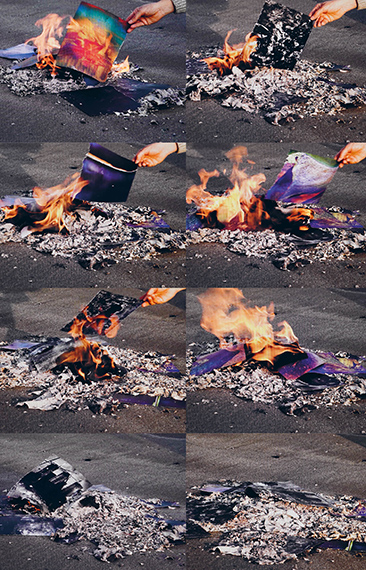
Burning Matter
Tiane Doan na Champassak » François Dufrene » Guerrilla Girls » Barbara Kruger » Jonathan Monk » Bruce Nauman » Ed Ruscha » Daisuke Yokota » & others
Exhibition: 23 Apr – 27 Nov 2022
Sat 23 Apr 18:00
Studio 454
Giudecca, Calle dell'Olio 454
30133 Venezia
+39-41-
Studio 454 is proud to announce the opening of the first show in a series of artist's book-related exhibitions co-curated by artist and collector Tiane Doan na Champassak and independent researcher Larisa Oancea.
Opening | April 23, 2022 | 6 pm
Live-set by Paolo Dellapiana
“Burning Matter” retraces the multiple uses of fire in the history of artists’ bookmaking since the early 1960s, documenting how this dual element – recognized in the literature as both a destroyer and a symbol of knowledge – has been absorbed into the creative research of a number of artists working with printed matter: Ed Ruscha, Bruce Nauman, Roy Adzak, Jonathan Monk, Bernard Aubertin, Barbara Kruger, The Guerrilla Art Action Group, John Latham, John Riddell, François Dufrêne, Daisuke Yokota and Tiane Doan na Champassak. “Burning Matter” is the first show in a series of artist’s book-related exhibitions co-curated by artist and collector Tiane Doan na Champassak and independent researcher Larisa Oancea.
When Prometheus crept into Hephaestus’s workshop to steal a spark of fire in the dead of night, he had already been warned by Zeus that every gift to humanity brings a punishment: “this is how the Fates weave destiny”. The polarity of fire has been a recurrent topic both in ancient and modern culture: its capacity to burn and transform, destroy and regenerate, enlighten and conceal has followed the history of humanity since its dawn. When it comes to books, the most obvious reference is undoubtedly Ray Bradbury’s “Fahrenheit 451”: here, fire represents equally the loss of freedom through destruction and the spread of knowledge in the face of censorship.
The relatively recent history of modern artists’ books – whose beginnings are commonly associated with Dieter Roth and Ed Ruscha – has itself occasionally been punctuated by the presence of this element. “Various Small Fires and Milk” by Ed Ruscha is a self-published book printed originally in 1964, in a limited edition of 400: a conceptual exercise gathering fifteen black-and-white images of domestic flames – candles, stoves, cigarettes, matches, lighters, among others – followed by a tall glass of milk as a visual pun that soothes the heartburn. Four years later, in 1968 – a year of increasing opposition to the Vietnam War – Bruce Nauman ripped out and set fire to Ed Ruscha’s iconic artist book. Nauman then photographed his pyrotechnic homage to form a new book – a publication in the form of a bound poster – titled “Burning Small Fires”.
Inspired by this performative activation of conceptual art, Tiane Doan na Champassak chooses to incinerate Daisuke Yokota’s “Matter / Burn Out”, adding a new layer of interpretation to an editorial project that was already in itself performative. There is a quiescent correspondence between Ruscha-Nauman’s and Yokota-Champassak’s historical momenta as both reenactments are, in different degrees, sensitive and responsive to the upheavals of their time. Champassak’s reenactment is a conceptual “mise en abyme” made visible through both a video art piece and a poster-format publication available in two versions: a limited edition of 275 copies and a special edition of 25 numbered copies, with an original burnt scrap from Yokota’s book.
The igniting lineage Ruscha-Nauman-Yokota-Champassak is completed in the exhibition by a wide range of variations on the perilous proximity – often vandalistic or iconoclast – between fire and books. Barbara Kruger’s “Matchbook”, John Riddell’s “Smokes: A Novel Mystery”, The Guerrilla Art Action Group’s “License to Burn Books”, François Dufrêne’s “Poème éclaté”, among others, reiterate how fire has reshaped the history of art-related printed matter.
With an awareness of the troubled times we live in, “Burning Matter” subtly evokes the sense of ritual power that fire continues to have in the culture of protest while underscoring its capacity to represent both an end and a new beginning.